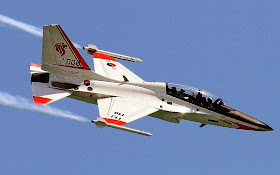 |
| Everybody likes a team-up! |
Both companies could use the boost. Boeing hasn't had the best of luck selling fighters lately. Meanwhile, Saab seems to really have trouble locking down Gripen sales. With T-X numbers expected to run anywhere from 350-1000, it's likely to keep both companies in the fighter 'business for the foreseeable future.
 |
| Saab Gripen used for the Empire Test Pilot's School (ETPS) |
Surprisingly, Boeing and Saab have announced that their T-X bid will be an all new, "clean sheet" design. Many, including myself, Guessed that Saab and Boeing would merely offer a stripped down Gripen. This would have the benefit of offering a proven, low cost design with very little risk involved. The Gripen is already used for the Empire Test Pilot School in the U.K, so why not offer a similar package for the T-X program?
While developing a Gripen trainer may be the less risky endeavor, it does face a few obstacles. For one, all the other aircraft in the T-X competition are already based on existing trainers. While the Gripen has an impressively low cost for a Mach 2 multi-role fighter aircraft, it likely doesn't fair that well compared to purpose built trainers like the BAE Hawk, KAI T-50, and the Alenia Aermacchi M-346. In effect, the Gripen is likely overkill.
But still, the costs involved with a clean sheet design would likely far exceed that of modifying an existing design, wouldn't it? My guess is that a Boeing/Saab entry will still be heavily based on the Gripen, with use of the GE 414 engine (used in both the Gripen E/F and the Super Hornet) almost a given. By going with a "clean sheet" design, Boeing and Saab get to greatly modernize the 25 year old Gripen design, using more economical production methods, etc. It should also be noted that Boeing considers the F-18E/F Super Hornet as a "all new" design compared to the legacy F/A-18 Hornet.
 |
| KAI T-50 Golden Eagle, the main rival. |
In comparison, the Alenia Aermacchi M-346 offers similar performance, but without the political or marketing clout (Alenia Aermacchi is already heavily involved in the JSF program). The BAE Hawk, while currently in use by the USN, is a relatively old design that cannot fly supersonic.
Both Boeing and Saab have a definite axe to grind with Lockheed Martin. Both have seen promising sales dashed away by the juggernaut that is the Joint Strike Fighter program, and neither are likely to pull any punches in the upcoming T-X competition.
 |
| Boeing T-X concept. |
There may be another reason for Saab and Boeing's "all new" design decision... It could offer the opportunity to come up with a true competitor for the F-35 in the fighter marketplace. The JSF's standout selling feature is that it truly is "the only 5th generation multirole fighter" available. This is absolutely true. Even upcoming designs like the PAK FA and J-20 appear to be strictly air-superiority 5th generation fighters, while the J-31 is still a huge unknown.
Boeing and Saab can use this opportunity to develop a true "5th generation fighter trainer", incorporating 5th generation features into an affordable, reliable platform. This makes sense in the context of the T-X program, which demands a trainer suitable for transition into fighters like the F-22, F-35, and future aircraft.
 |
| A scale model of Saab's Generic Future Fighter "GFF" concept (look familiar?)... Could this be the shape of things to come? |
Along with modernizing the Gripen into the Gripen NG, as well as studying a carrier capable "Sea Gripen", Saab has been working on a "Generic Future Fighter" (GFF) concept. The GFF is meant to be a low cost platform with internal weapon carriage, supercruise, and stealth capabilities, making it a true 5th generation design.
Could Boeing and Saab's "clean sheet design" for the T-X competition look like Saab's GFF? Could it be Saab and Boeing's way of providing a truly affordable "5th generation" fighter design?
This could be interesting.
No comments:
Post a Comment